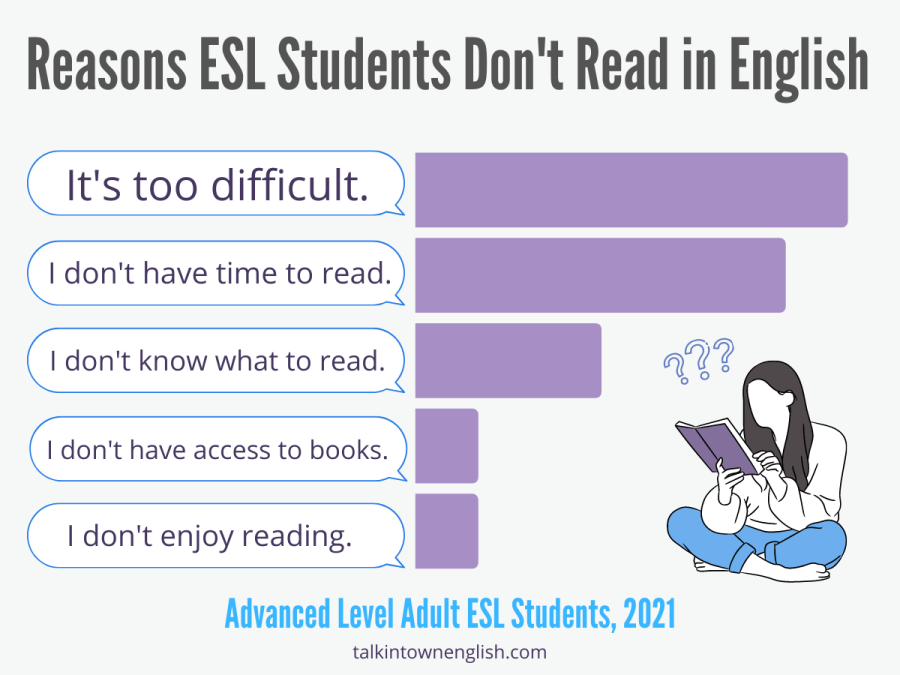Every year, I do a New Year’s Resolutions writing task. I ask my students what their goals are for the coming year, and how they plan on reaching those goals. I’m always pleased to find that reading more in English is always at the top of their lists. It’s right up there with “lose ten pounds by summer.” And sadly, likely to have the same paltry success rate.
Let’s face it. If our ESL students aren’t reading now, what’s going to change that? ESL teachers know that reading is essential to language acquisition, and the science backs it up. So how can we encourage students to find fluency through fiction?
We can begin by looking at the reasons why ESL students aren’t reading books in English. With a better understanding of what the individual roadblocks are, we can begin to pave the way for confident and successful readers.
To find out why my ESL students aren’t reading, I surveyed a class of 18 advanced adult learners. Here are the top five reasons those students aren’t reading more in their target language.

Out of 18 students, one admitted that they didn’t enjoy reading, and one replied that they don’t have access to books. The remaining 16 students gave other reasons for not reading books in English: that reading in English is too difficult (38.9%), that they don’t have time to read (33.3%), or that they don’t know what to read (16.7%).
Before we look at some solutions to the most common reasons students don’t read more, let’s go back to the weight loss analogy. If someone (me) really wanted to lose ten pounds, I would need to hire a personal trainer. I would need someone to meet me at the gym, find the workout equipment that’s right for me, and make the process fun and engaging. That’s what trainers are for.
If teachers are going to commit to helping develop reading competency and confidence among our students, we’ve got to go in with a personal-trainer mentality. That is the level of support students will need in order to become habitual readers:
- They’ll need motivation and the support.
- They’ll need help choosing appropriate material for their level and interests.
- They may also need milestones and objectives to complete so they can taste success as they go.
The ultimate goal is to guide students to a place where reading becomes a pleasurable experience rather than a bore or a chore. To get there, let’s look at some typical excuses I hear from students who genuinely want to read but can’t quite get past the title on the cover.
Reading in English is too difficult.

When a student laments that reading books in English is too difficult, you can suggest they try out a children’s book, but remember: while reading materials must be level-appropriate, equally important is that your students actually enjoy what they are reading.
Many students will feel silly reading “baby books” full of cartoon characters and goofy storylines. On the other hand, many popular “young adult” books (like Harry Potter) will be too difficult for beginner and intermediate learners.
How To Help
One way to make reading more “user friendly” is to provide students with techniques and reading strategies that can help them navigate a text.
Get 7 great strategies for ESL reading success in the classroom here.
Once students have a handle on some effective reading techniques like visualization and scanning, you can begin to recommend books that are level-appropriate.
Level-Appropriate Materials
Doing a quick internet search for appropriate reading materials can be anything but quick! I’ve spent hours sifting through sites (and searching my own brain) for the best books to boost reading in the ESL classroom. I recommend the following searches, links, and compilations:
- materials specifically designed for ESL readers for each specific level
- picture books with no (or very few) words that students can narrate
- audiobooks for ESL students that can be read and listened to at the time
- abridged versions of the classics (and why you shouldn’t shudder at the thought!)
- Cliff’s Notes to introduce more difficult works of fiction
- Newberry Award Winners
Age-Appropriate Materials
Ask your students about their interests, favorite authors, and cultural backgrounds. Find out what line of work they are in, or plan to work in. Their answers may give you insight as to the perfect book for them. By doing a search together with your student, you can help them narrow down some of the overwhelming choices out there.
I don’t have time.

Whenever a student blurts out, “I want to read, but I don’t have time”, I always think: You do have time. You just don’t want to spend it reading.” But I hold my tongue. I would never say this out loud because it might actually be true.
We are all busy people, and it’s not fair to assume that everyone actually does have time to read. If your students are honestly telling you that they don’t have time to read, don’t press them on it. Instead, ask them if there was a time when reading was a bigger part of their lives. Which books do they remember reading? Who are their favorite authors? The conversation may inspire them to proactively make time for reading in the future.
How to help
While some students might honestly not have time to read, others may just be feeling unmotivated to actually sit down and do it. For those students, I offer the following advice: Stop thinking of reading as a hobby, and make it your job instead.
Stop thinking of your reading as a hobby, and make it your job instead.
Reading in a second language takes effort. If students think of reading as a leisure activity, they will never be able to “find” the time to do it. If they can think of reading as part of their study load, however, they are more likely to prioritize reading and find ways of squeezing in a few extra minutes into their study hours. Here are a few more ways to find time for reading:
- Put the “ding” in reading with time limits. I recommend students set aside just 5-10 minutes a day to practice reading, and use a timer to help them meet their goal. The time limit keeps feelings of frustration at bay and leads to positive outcomes.
- A time and a place. To make reading a regular habit, it’s important that students read in the same place, at the same time each day. The reading should be done when they feel relaxed and comfortable.
- Host a 30-day reading challenge. Set a goal for students to read for 30 minutes by the end of the month, and have a small celebration at the end of the challenge!
- Make time in class for reading. Give students 15 minutes at the beginning or end of class. The time can be used as a quiet reading time, book circle discussions, or for providing struggling students with individual guidance.
- Implement literacy-based activities. For example, choose 5-7 books of various genres and eras. Copy the first paragraph of each book onto a blank page with the titles displayed separately in random order. Give it to students as a challenge to match the title with the paragraph. Then engage students by asking them which book they would most like to read, and why.
Get your 30-Day Challenge template to customize here.
Find more literacy-based lessons in my shop.
I don’t know what to read.

Choosing a book in English is hard enough for native speakers; imagine having to choose a book in a second or third language!
How To Help
If your students are from international communities abroad, they probably didn’t read the “classic” books that are spoon-fed to American children. The stories we grew up with might be the first books that come to mind, but they may not always be the best choice for current language learners.
What’s more, many of those “classics” include dated language. They may exclude or denigrate cultures and identities as well. It’s a great time to take a critical look at the books and authors we’ve come to know and love and ask ourselves whether they deserve our continued loyalty.
- Look for newly released books that contain relevant issues and inclusive character portrayals
- Go browsing. Organize trips to the library for the purpose of choosing a book. Thrift stores and dollar stores will also have a variety of affordable books for students to explore.
- Let the books find the students. Readers know all about the concept of serendipity when it comes to books appearing suddenly and at the perfect moment in your life. It’s a super fun word to teach, too.
Start with the Basics
If you do decide to go with the classics, you’ll need to preview the language and think carefully about the book’s message and character. How will the story benefit your students? Will they find the characters relatable? Reading is a deeply personal experience for all readers. Here are some of my own favorite selections from when I was young and now again as a parent reading to my child.
- Dr. Seuss. Although Dr. Seuss has taken some post-humous heat recently for some of the messages and depictions in his stories, the intrinsic value of his works should not be completely disregarded because of a few bad apples up on top! I still recommend (with love) The Cat in the Hat, The Lorax, and Horton Hears A Who. These three books have interesting storylines and a wealth of practice for pronunciation, intonation, and rhyme schemes.
- Roald Dahl. His stories like Matilda, The BFG, and James And The Giant Peach have drawn young readers into his wacky, wild world for over 40 years. His tales are full of colorful characters and fantastical storylines, which are sure to capture the hearts of readers from every background.
- Madeline, Madeline’s Rescue, by Ludwig Bemelmans
- My Side of the Mountain, by Jean Craighead George
- The Secret Garden, by Frances Hodgson Burnett
- A Wrinkle in Time, by Madeleine L’Engle
- Island of the Blue Dolphins, by Scott O’Dell
- Charlotte’s Web, by E.B. White
- The Chronicles of Narnia, by C.S. Lewis
- The Life of Pi, by Yann Martel
- The Incredible Journey, by Sheila Burnford
- The Celestine Prophecy, by James Redfield
- The Alchemist, by Paolo Coelho
- The House of Spirits, by Isabelle Allende
Choose from Online Lists
- translations of books they have already read in their first language
- children’s books that are related to a student’s culture, country, occupation, or interests
- self-improvement books
- fables, fairy tales, myths, and legends
- best books for ESL
I don’t have access to books.

Some ESL students are studying English from their home countries and have limited access to English language texts. Those students will help finding resources they can use to browse, download, or order texts online.
For students living in English-speaking countries, not having access to books is an unfortunate reality as well. For one thing, libraries and bookstores have been closed or limited since the pandemic. For another, books are scarce to come by these days. My own personal library has been downsized as I have Marie Kondo-ed most of my books over the years. But don’t worry. There are lots of ways to get real, live books into the hand of your students.
How To Help
- Plan class trips to local libraries. If you call in advance, librarians will often be happy to give a tour and help guide students through the process of obtaining a library card.
- Go thrifting. Provide students with a list of local bookstores and thrift stores where they can buy books.
- Scour craiglist. Local selling apps for yard sales or book collections that are free or cheap.
- Map out little free libraries in your neighborhood. Click here for a map of each location.
- Start a little free library of your own at school.
- Ask friends and family members for books to donate and hold a book drive.
- Turn to technology. The path of least resistance is to stop pushing physical books on students and instead embrace ebooks and e-reading apps like Kindle. Help students choose a book and order it online, or search for free PDFs to download. Many great authors have lesser-known texts that are available for free or at a discount.
I don’t enjoy reading.
When a student tells you they don’t enjoy reading, it might be tempting to just throw up your hands, but please don’t! The most honest of all answers deserves a careful (and caring) response. These students may have had negative experiences with reading in their L1, they may not see the value in reading, or they may enjoy more social activities as extroverts. Talk to them about why they don’t like reading, and help them find ways around it.
I don’t enjoy reading in my L1.
If a student never found joy when reading in their first language, reading in English will be about as appealing as a trip to the dentist. Reading may be more alluring when it is task-based, so provide texts with questions to answer about those texts. Genres I recommend for these readers are self-help books, biographies, and books that have a movie version. Yes, a movie version.
I do enjoy watching movies.
Should ESL students watch a movie version of a book before they read it? Some people might give you the stink eye for even asking such a ridiculous question. Of course, you read the book first! While I tend to agree with them for native speakers, I recommend the opposite for ESL students. Watching the film version prepares and motivates them for reading, gives them character cues, and offers a general understanding of what they are going to be reading. To make the process more academic, have them watch it again after they read it to compare them.

Reading is boring.
Reading is one of the few activities that we do completely alone. For many extroverts, the idea of sitting alone with a book is actually painful. For these students, I recommend:
- starting or joining a book club and/or a social media group that meets to talk about reading. The social aspect will appeal to those who need the exposure. Check out Oprah’s Book Club or other celebrity readers.
- reading in public is another way to add interaction to their reading experience.
- adding excitement. Do you remember the Choose Your Own Adventure books? These are more like role-playing video games, where the reader is given choices that determine how the story unfolds.
- going with audiobooks so at least they are getting exposure to the language of written works.
- celebrate reading with holidays and seasons. Summer reading lists are always hot, October is the season for scary stories, and Read Across America Day is March 2. Throw a reading party to celebrate.
Reading isn’t rewarding.
It’s important for students to truly understand the value of the written word. To erase all doubt from their minds, expose them to the research studies that show:
Students who read more outperform those who don’t in a variety of language skills.
Chocolate is rewarding.
Have your students choose a reward for their reading progress. It can be something small, like a candy bar, a trip to the movies, a night out, or a new pair of shoes. Dangling a carrot gives them something to look forward to after completing their reading goal. Whether it is completing a chapter or an entire book, rewarding both large and small accomplishments is a great way to help students form strong reading habits.
Read by example.
My final word here is that the best thing you can do encourage your students to read more is by being an avid reader yourself. Our students are interested in our own habits and preferences. Be sure to share your feelings about reading. Talk about a book you are currently reading and why you’ve been enjoying it. Tell them how often you read, where you read, and how long you read for. Reading benefits us all, so don’t be shy to show them how much you love it. The feeling might be contagious.
Thank you for reading through. Let me know your own tips and tricks for helping your ELLs with their reading in the comments below.


graliontorile
You should take part in a contest for one of the best blogs on the web. I will recommend this site!